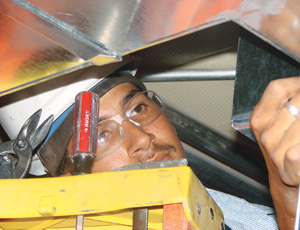Despite bumps and twists in Arizona’s commercial and housing construction markets, builders and high-school educators there have linked to keep the craft pipeline full for an anticipated market revival and expected retirement-driven workforce gaps.

“We believe the economic downturn is a temporary phenomenon, and when it’s over, we will have more work than we have skilled labor,” says Dave Pittman, director of the Southern Arizona division of the Arizona Builders’ Alliance, a statewide contractor group whose 400 members include both union and nonunion firms. It teamed with the Pima County Joint Technological Education District (JTED) in Tucson last year to expand and equip a “learning laboratory” in a local magnet high school to teach electrical and HVAC trade skills to students.
Participants say Arizona’s construction market is poised for recovery. “Ever since the invention of air conditioning, Arizona has been one of the fastest growing states in the country,” says Pittman. “Demographers say in the next 30 years, it will more than double in size, and that means work for the construction industry. We’d be shortsighted to think we will not need construction workers in the future.”
While demand for some entry-level trades is declining, there is still work for skilled apprentices in the Tucson area, says Larry Copenhaver, ABA craft training coordinator. He notes that four of the division’s 160 members donated more than $100,000 in equipment and upgrades to enhance and expand existing vocational education space at Catalina High Magnet School. It is used by the school during the day and by ABA at night for its four-year nonunion craft apprentice programs.
The builders’ organization has 62 HVAC and electrical trades’ apprentices at Catalina and another 12 apprenticing in plumbing at Tucson-based Pima Community College, where tight space precluded building the new lab facilities. Under an agreement, the high school rents the space to ABA for $1 per year for five years, with an option to renew after that. The improvements and equipment became the property of the school district.
Eight students are now taking the new HVAC class, which meets at 6:30 a.m., before their regular classes begin. Another group will soon start early morning electrical-skills training.
“There is no question about the need,” says Tom Ross, safety and labor coordinator for Wilson Electric Services Corp., Tempe, an ABA member that hires its apprentices and installed the lab’s lighting and power receptacles. “It was a way to help them and an opportunity for our guys to learn,” says Ross.
Paul Chavez, a superintendent in the Tucson office of Helix Electric Inc., recently interviewed a dozen ABA apprentices for upcoming barracks work the firm has at nearby Fort Huachuca, which houses several major Army commands. In addition, he expects a shopping mall project to move forward this month.
Madera Mechanical Inc., Tucson, donated the lab’s ductwork and installed it. We’ve never had an adequate number of sheetmetal workers to apprentice,” says Kevin Warner, vice president. “We’re committed to vocational education.”
Recession-strapped technology educators could not be happier. “With current budget problems, it was a huge deal to have that kind of support,” says Aaron Ball, JTED’s director of program development. “It has expanded the [construction program’s] ability to appeal to a broad range of students.”
Hollis Simmons, lead building and construction trades instructor at the Catalina school, says the lab “has enabled me to start another program for my students.” Copenhaver says the effort is “building a synergy between the vocational programs at the high school level and apprenticeship. It is a way to make young people aware of the advantages and opportunities in apprenticeship.”


Post a comment to this article
Report Abusive Comment